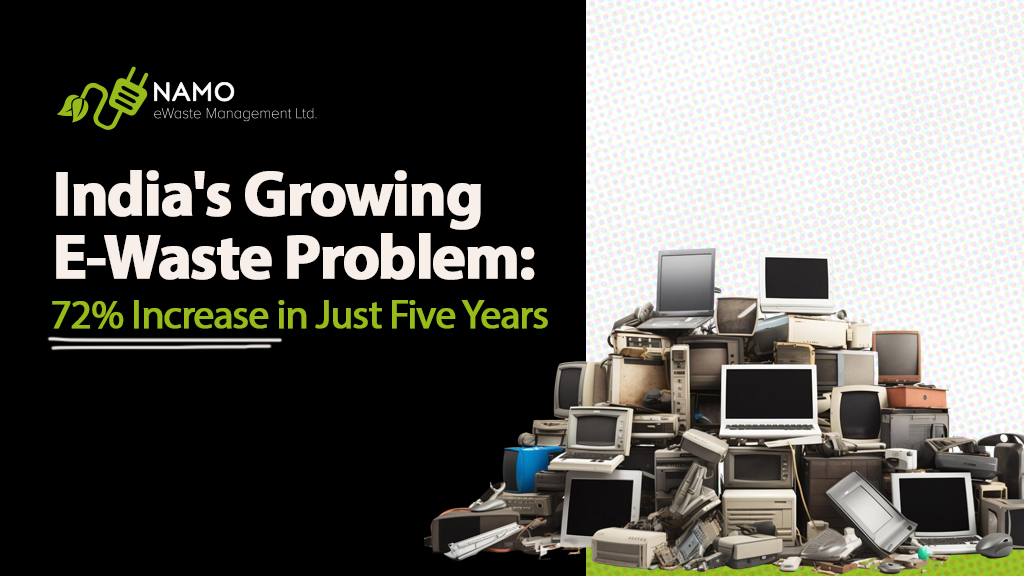India’s Growing E-Waste Problem: 72% Increase in Just Five Years

The Troubling Rise of Electronic Waste At Namo E-Waste, we’ve been tracking India’s electronic waste situation closely, and the numbers are honestly shocking. According to recent data from the Ministry of Housing and Urban Affairs, India produced about 1.75 million metric tonnes of e-waste last year (2023-24). When you compare that to what was happening five years ago, that’s a 72% jump! India now ranks third globally in e-waste generation, just behind China and the US. What’s particularly concerning to us is that only around 30% of this waste gets properly recycled through official channels. The rest? It’s either handled informally (which often means unsafely) or simply left untreated. If nothing changes, experts believe India could be generating 5 million tonnes annually by 2030. That spells trouble for the environment, public health, and the economy – issues we at Namo E-Waste are committed to addressing. How Bad Has It Gotten? Looking at the yearly breakdown: Financial Year E-Waste Generated (Metric Tonnes) 2019-20 1,014,961 2020-21 1,346,496 2021-22 1,601,155 2022-23 1,609,117 2023-24 1,751,236 The trend is clear and worrying. While India has become a digital powerhouse with over a billion smartphone users (making it the second-biggest smartphone market worldwide), it’s struggling with one of the lowest formal recycling rates among major economies – a gap our company is working to bridge.
How to Recycle Lithium-Ion Batteries to Reduce E-Waste

Lithium-ion batteries power our modern world, from smartphones and laptops to electric vehicles and renewable energy storage systems. But in the same wave of increasing dependence on such energy sources, there also arises an equal concern: what happens once the batteries themselves have reached the end of their lifecycle? Improper disposal of lithium-ion batteries contributes strongly to electronic waste, which poses environmental hazards as well as increased safety risks. Recycling these batteries is a critical step toward reducing e-waste and conserving valuable resources. This blog explores why recycling lithium-ion batteries matters, how the process works, and what individuals and organizations can do to contribute to a sustainable future. Why Recycling Lithium-Ion Batteries is Crucial Lithium-ion contains materials such as lithium, cobalt, nickel, manganese, and graphite, which are limited in reserves. Extracting these materials requires mining, an energy-intensive process, usually damaging ecosystems, contributing to greenhouse gas emissions, and social and ethical concerns in mining communities. Recycling can decrease demand for virgin material and associated environmental impact. Besides, lithium-ion batteries are dangerous if they are sent to the garbage, as they may be prone to catching fire or explosion owing to residual charge. Also, e-waste including the toxic chemicals inside can leach into soil and water, harming both ecosystems and human health. How Lithium-Ion Recycling of Batteries Helps in Reducing E-Waste The problems for which recycling of lithium-ion batteries is relevant include: Resource Recovery: Recoverable metals such as cobalt, nickel, and lithium are recovered and reused in other new batteries or applications. Waste Reduction: Recycling reduces the amount of hazardous materials that end up in landfills or incinerators. Energy Savings: More energy is saved in making new batteries from recycled materials than if raw resources were used. Environmental Protection: Proper recycling ensures toxic substances do not contaminate the environment. The Lithium-Ion Battery Recycling Process Recycling lithium-ion batteries takes more than a few steps. Sorting of useful extractable materials and dangerous materials must be undertaken to the highest safety standards. Collection and Transportation The first step is the collection of used batteries and transportation to the recycling plant. Specialized containers are used to avoid accidents such as short circuits, fires, or leaks during transport. Sorting and Disassembly The facility sorts the batteries by chemistry and size. Lithium-ion batteries differ in type-most are cylindrical cells in construction, commonly found in power tools, while others are pouch cells in smartphones. At some facilities, workers manually disassemble the batteries to separate casings, electrodes, and separators. Pre-Treatment The pre-treatment entails shredding or dismantling the batteries to unveil internal components. In some cases, the batteries freeze to prevent combustion before shredding. Material Recovery The core materials are extracted using chemical, thermal, or mechanical methods. Pyrometallurgy, or High-Temperature Processing: Smelting of batteries to extract metals such as cobalt, nickel, and copper. This method requires huge amounts of energy and may give off emissions. Hydrometallurgy, or Chemical Leaching: Metals are dissolved in a solvent and separated and purified. This is more efficient and less dangerous for the environment. Direct Recycling: This emerging technology preserves the battery’s cathode materials, allowing them to be reused without extensive processing. Refining and Reuse Recovered materials are refined to meet industry standards and sold to manufacturers, often for use in new batteries. Challenges in Lithium-Ion Battery Recycling Despite its benefits, lithium-ion battery recycling faces several challenges: Complexity: Lithium-ion batteries contain multiple materials and chemistries, making it difficult to standardize recycling processes. Economic Feasibility: For any battery containing low cobalt, recycling costs outweigh the value of recovered materials. Collection Infrastructure: Drop-off locations are scarce, and consumers are not informed about where to take or drop off the batteries. Safety Issues: Lack of proper handling during collection or processing could result in fires or chemical exposure. How to Recycle Lithium-Ion Batteries A Step-by-Step Guide to Consumers As a consumer, we can actually help in reducing e-waste by recycling lithium-ion batteries appropriately. Here’s how: Identify Recyclable Batteries Check the product labels or user manuals to identify whether your battery is lithium-ion. Common products include: Smartphones Laptops Power tools Electric vehicles Avoid Improper Disposal Do not dispose of lithium-ion batteries in landfills or regular recycling bins. These may lead to fires or contamination in landfills. Find Recycling Programs Look for collection centers using: Retail stores (many electronics stores accept used batteries). Municipal e-waste collection programs. Companies or websites specialized in battery recycling. Prepare Batteries for Recycling Moisten and tape the terminals to avoid short circuits. Store batteries in a cool, dry place until you drop them off. Spread Awareness Educate friends, family, and colleagues about recycling lithium-ion batteries and share resources that might make the process easier. Corporate Responsibility in Battery Recycling Organizations and producers play a very great role in managing e-waste. There are several things that can be done: Extended Producer Responsibility Under EPR policies, manufacturers are responsible for the end-of-life handling of their products, including their batteries. This involves establishing take-back programs and ensuring proper recycling. Innovation in Design Companies can design batteries to be recyclable, use less toxic materials, and be more easily disassembled. Recycling Infrastructure Investment Investment in recycled infrastructure can support more advanced recycling technologies, including direct recycling, to make the process more efficient and less costly. Partnership with Recyclers An organization could partner with a qualified recycling business that ensures the used lithium ion batteries are sent to them to ensure responsible disposal. Future of Lithium Ion Batteries Recycling The growth in the demand for lithium-ion batteries is accompanied by the need to do so sustainably. All engaged governments, businesses, and consumers must come together to develop a circular economy for their batteries; there should be a continuous reuse of the materials rather than getting them wasted. New technologies being developed include AI-powered sorting systems, direct recycling methods, and re-use applications for batteries to achieve this objective. Conclusion Lithium-ion battery recycling is essential as it will help cut the waste rate of e-wastes; it will help save natural resources and protect the environment. Understanding importance in taking the right action—whether as

